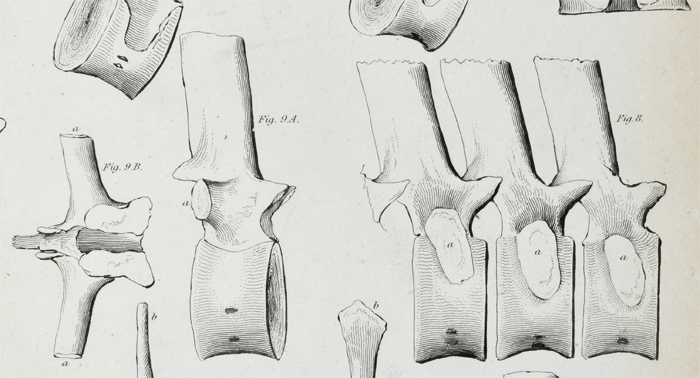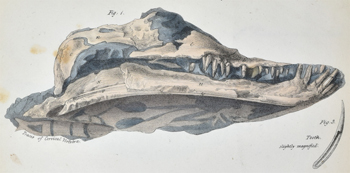Reconstructing a new animal

|
| Vertebrae of the new creature in the collection of Col Thomas Birch, from H T De la Beche and W D Conybeare, "Notice of the discovery of a new Fossil Animal, forming a link between the Ichthyosaurus and Crocodile, together with general remarks on the Osteology of the Ichthyosaurus", Transactions of the Geological Society of London, S1-5 (1821). GSL Library collections. |
The new animal which Henry De la Beche and W D Conybeare discovered was first described in their 1821 paper "Notice of the discovery of a new Fossil Animal, forming a link between the Ichthyosaurus and Crocodile, together with general remarks on the Osteology of the Ichthyosaurus” [Transactions of the Geological Society of London, S1-5 (1821)]. The paper suggested that the shapes of these bones indicated that the creature was an intermediate between the ichthyosaur and a crocodile, that is nearer to a lizard hence the name - ‘Plesiosaurus’ [Greek plesion = near].
There were limits on what could be reconstructed from these mostly disjointed bones, mainly because so much was missing including the head. Conybeare’s next paper in 1822 included an anatomical description of the single example of an extremely crushed plesiosaur skull which had been found in Street, Glastonbury.

|
The crushed plesiosaur skull from the collection of Thomas Clarke which was found in Street, Glastonbury, from W D Conybeare, "Additional Notices on the Fossil Genera Ichthyosaurus and Plesiosaurus”, Transactions of the Geological Society of London, S2-1 (1822). GSL Library collections. |
The first almost complete, articulated plesiosaur skeleton was found by Mary Anning on 10 December 1823.
<<Back
Next: Plesiosaurus dolichodeirus >>